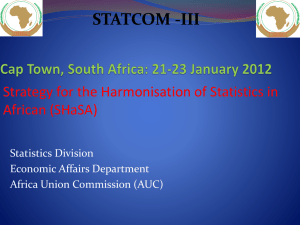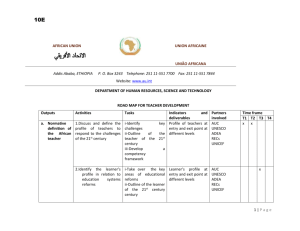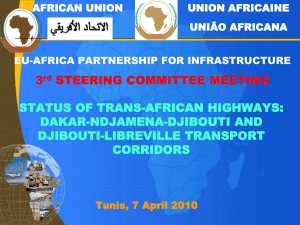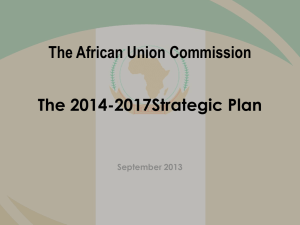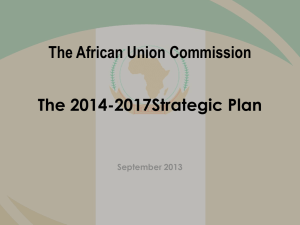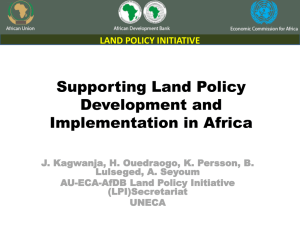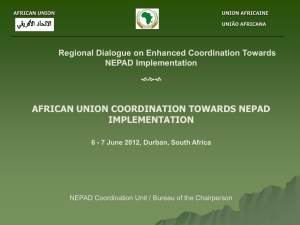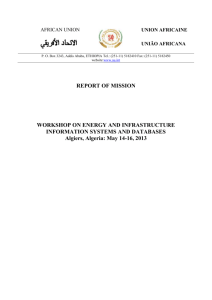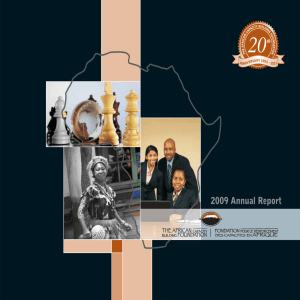SHaSA - Paris21
advertisement
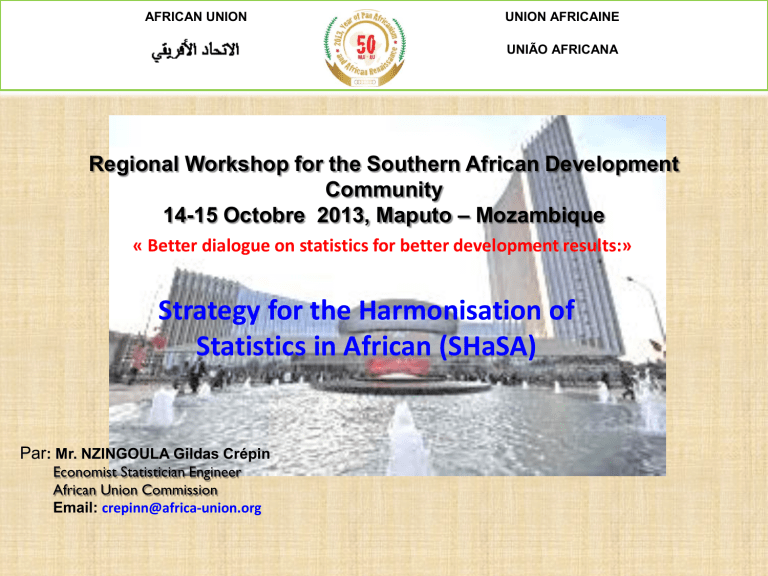
AFRICAN UNION UNION AFRICAINE UNIÃO AFRICANA Regional Workshop for the Southern African Development Community 14-15 Octobre 2013, Maputo – Mozambique « Better dialogue on statistics for better development results:» Strategy for the Harmonisation of Statistics in African (SHaSA) Par: Mr. NZINGOULA Gildas Crépin Economist Statistician Engineer African Union Commission Email: crepinn@africa-union.org Plan of Presentation I. II. III. IV. Introduction Priority statistical requirements What is SHaSA? Implementation mechanism V. A map of statistical government in Africa VI. Integration area & existing initiatives social & cultural dimension VII. Conclusion I. Introduction The process of socio-economic, political and cultural integration has always been a core concern of African leaders; Since 1960 several initiatives and legal frameworks adopted at the highest level have succeeded to accelerate the integration process and to ensure its sons and daughters good quality, economic and social welfare; For it to fully succeed and ensure that they achieve their objectives, it requires not only quality statistical information, but also harmonized data across time and space in all areas of African integration. II. Priority statistical requirements Policy frameworks structuring the African integration process allows us to highlight three major dimensions of integration, namely: Political integration and regional and continental governance, Economic integration, and Social and cultural integration III. What is SHaSA? SHaSA: continental effort that directly supports the African integration agenda; Objectives; – – – Identifying key priority areas of the African integration process that need to be underpinned by statistics; Assessing the state of the ASS and various initiatives on statistical harmonisation; and Elaborating a continental Strategy for the production and dissemination of quality harmonised statistics to inform African development and integration efforts Jointly prepared by AUC, AfDB and ECA. III. What is SHaSA? (cont.’) Strategy Themes Strategic Theme 1 Strategic Theme 2 To Produce Quality Statistics for Africa To Coordinate the Production of Quality Statistics for Africa Reliable and harmonized statistical information, covering all aspects of political, economic and social Strategic Theme 3 To Build sustainable Institutional Capacity of the African Statistical System Strategic Theme 4 To Inculcate a Culture of Quality Decision-making Strategic Theme 1: To Produce Quality Statistics for Africa Strategic objective 1 To Expand the Statistical Information Base Strategic objective 2 Strategic objective 3 To Transform existing Statistics for Comparability To Harmonise Standards and Methods of Statistical Production Strategic Theme 2: To Coordinate Production of Quality Statistics for Africa Strat. objective 3 Strat. objective 1 To Strengthen Cooperation among Institutions within the African Statistical System Strat. objective 2 To Establish an effective Coordination Mechanism To Define Statistical Priorities to Implement the Integration Agenda Strategic Theme 3: To Build sustainable Institutional Capacity of the ASS Strategic objective 1 To Ensure the Autonomy of Production. Strategic objective 2 Strategic objective 3 To Build sustainable statistical Capacity. To Establish an effective technological Environment Strategic Theme 4: To Inculcate a Culture of Quality Decision-making Strategic objective 1 Strategic objective 2 To Drive evidenceTo Improve based Decisions Communication of through the Use of Statistical Statistics. Information SHaSA Group No 01 STG Leader LC Composition Governance, Peace & Security External Sector (External Trade & Balance of Payments) AUC ECA, AfDB, ACBF, RECs, MS AUC ECA, AfDB, ACBF, RECs, Afristat, MS 03 Money & Finance AACB AUC, ECA, AfDB, ACBF, RECs, MS 04 National Accounts & Price Statistics AfDB AUC, ECA, ACBF, RECs, Afristat, MS 05 Infrastructure, Industries & Tourism AfDB AUC, ECA, ACBF, RECs, MS 06 Public Finance, Private Sector & Investments AfDB AUC, ECA, ACBF, RECs, Afristat, MS 07 Science, Technology & Education AUC AUC, ECA, ACBF, RECs, MS 08 Demography, Migrations, Health, Human Development, Social Protection & Gender UNECA AUC, AfDB, ACBF, RECs, Afristat, MS 09 Agriculture, Environment & Natural Resources UNECA AUC, AfDB, ACBF, RECs, FAO, MS 10 Statistical Training & Capacity Building ,UNECA AUC, EAC, RECs, MS 11 12 Informal Sector Classification Afristat UNECA AUC, AfDB, UNECA, RECs, MS AUC, AfDB, Afristat, RECs, MS 02 IV. Implementation Mechanism Committee of DGs: Monitoring the implementation of the strategy as well as its pillars, Making appropriate recommendations for its effective implementation, Preparing reports on its implemetation to the Ministers Finances, Planning and Economic Development and the Summit of Heads of State , Considering and adopting statistical programmes based on data requirements for the integration agenda, as well as actions/programmes for their provision. V. A map of statistical governance in Africa VI. Integration areas & existing initiatives Social & cultural dimension Integration area Trade Statistical area Statistical initiative Wholesale & retail trade, motor trade, hotels and restaurants African Strategy for the Implementation of the 2008 System of National Accounts Balance of payments Strategy for the harmonization of International Merchandise Trade Statistics (IMTS) Foreign trade Prices Implementation Plan for the International Comparison Program for (ICPAfrica) Monetary and finance integration Currency and finance Public finance African Monetary Cooperation Programme Economic cooperation and partnerships National accounts Investments African Strategy for the Implementation of the 2008 System of National Accounts Transport Transport infrastructures Infrastructure Statistics Industry Manufacturing African Strategy for the Implementation of the 2008 System of National Accounts Energy Energy infrastructures Infrastructure statistics VII. Conclusion Comparable statistics across countries will be generated to inform on the implementation of integration and for decisionmaking: the adoption of international standards and common methods adjusted to African realities; and better coordination of statistical development efforts and sustained production of harmonized statistics to inform policy decisions. Thank for you kind attention! Website:: www.austat.org
